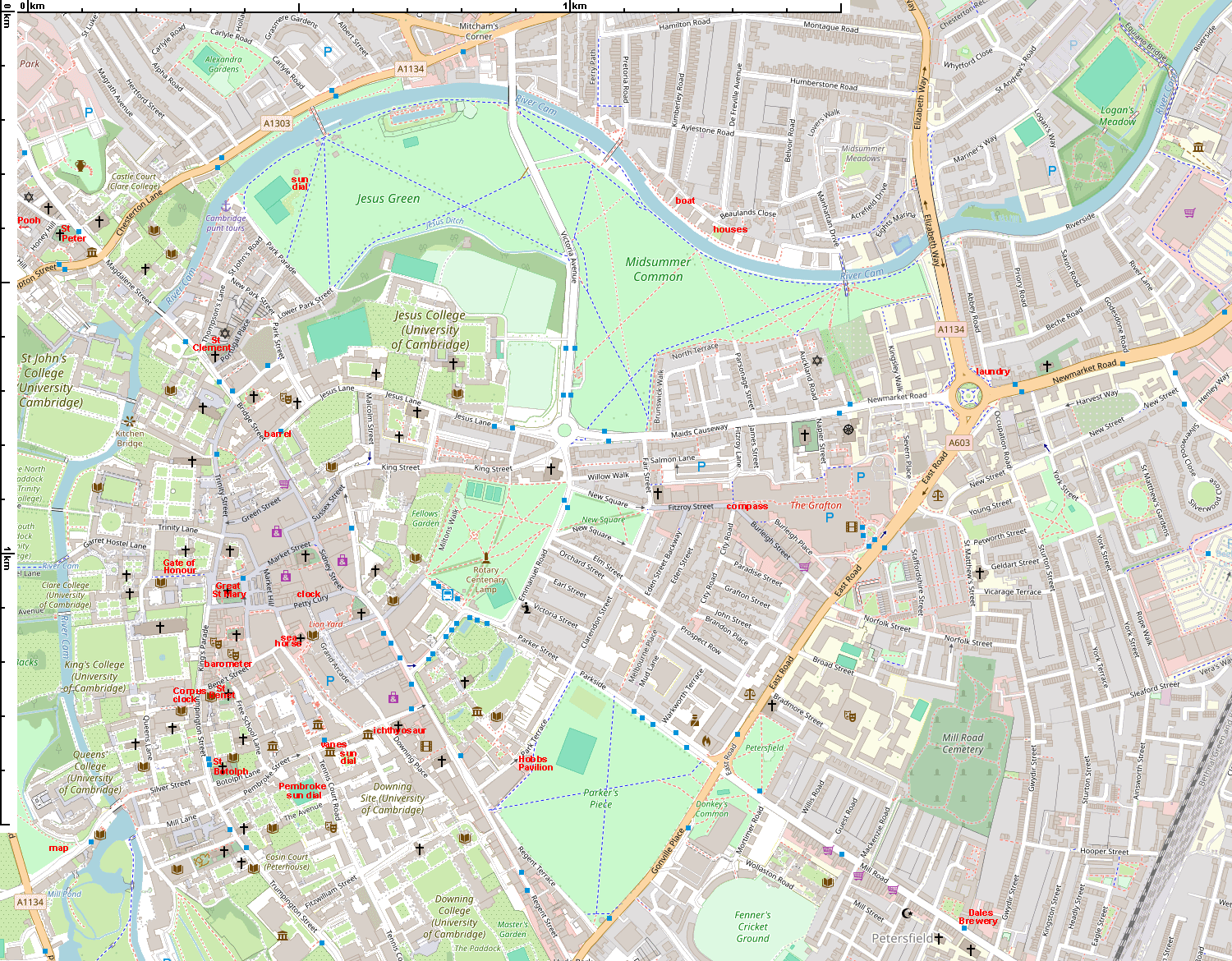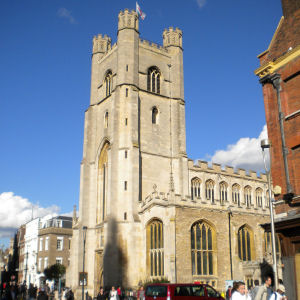 Weather vanes, etc.
Weather vanes, etc.


 Weather vanes, etc.
Weather vanes, etc.

There are various instruments in Cambridge, such as weather vanes, clocks, etc on Cambridge colleges, boat houses, churches, etc. I have restricted myself to what can be seen from public paths. Some colleges have sun dials only visible from inside the college.



Great St Marys on Kings Parade has an old clock dated 1679. It also has 3D maps in front, see below.
This is the Corpus Clock, a fully functioning mechanical clock that shows the time without using hands. A part of mechanical clocks which converts pendulum motion into rotational motion is called a grasshopper escapement. In this clock, it really looks like a grasshopper. It is called the Chronophage or "time eater". It moves backwards and forwards on the cogs of the wheels. Its eyes blink at random. Every minute, its mouth opens, showing needle-like teeth. Then it shuts, eating the minute.
There are three circles of dots which show the hour, minute and second. The clock seems to hestitate from time to time, so the clock is accurate every five minutes rather than all the time. Under the clock is carved a quotation from 1 John 2:17 "Mundus transit et concupiscentia eius" or "The world passeth away, and the lust thereof." The first word looks like MUDUS rather than MUNDUS, but there is a line over the first U. This is a scribal mark showing that the word has been abbreviated. Click here for more on the clock and its maker.
This clock is in Petty Cury. I suspect that it isn't working.
This clock is on the side of the Dales Brewery site (now various businesses such as antique shops and a coffee shop). I suspect that it isn't working. Click here for more about Dales Brewery.
The Gate of Honour, in Gonville and Caius college, in Senate House Passage, has several sun dials on top.
On the lawn within the Downing Site. From sundial walk: "The rather battered sundial near the Downing Street entrance to the site is actually a collection of 17 dials all cut into a single block of stone. The sundial was presented by Professor Sir William Ridgeway (a famous archaeologist and classical scholar) and his wife Lucy in 1913. Their daughter, also named Lucy, married the son of John Venn (of diagrams fame). Sir William and (daughter) Lucy later set up the University's Ridgeway-Venn Travel Fund. According to University Ordinances, the first call on this Fund is for the maintenance of this sundial."
St Botolph's church, in Trumpington Street, has sun dials on its tower.
This dial is on the wall of Foundress Court, Pembroke, designed by Eric Parry Architects and built in 1997. It won a commendation from the British Sundial Society. This view is from outside the college, on Tennis Court Road.The helpful graph lower right shows that in February sundials are about 15 mins slow of GMT. The photo was taken at 14:31; so the adjusted time is correct within the limited accuracy with which the dial can be read. The shadow of the ball indicates the season, falling on the upper or lower curves at the solstices, and the straight (but slanting) centre line at the equinoxes.
Beyond the tennis courts, there are some flat stones laid out in the grass (and easy to overlook - they are not the barbecue stones, or the bandstand!) These are the Human Sundial. This needs a person to complete it. You stand on the mark, and your shadow shows the time. Click here for more about it. The Human Sundial is in memory of Vernon McElroy and was unveiled in 2014. Vernon McElroy was a member of the Rotary Club of Cambridge Rutherford, and he conceived the idea of this sundial a year earlier.

Hobb's Pavilion, on Parkers Piece, used to be changing rooms for cricketeers. It is now a restaurant.
In the Downing Site, above the Sedgwick Museum, there is a weather vane with an ichthyosaur on it!
Along the front of the Downing Site, there are several weather vanes, presumably to see if the wind is in the same direction. Apparently not...
St Peters is on Castle Street. At the top of the spire is a weathervane with the initials A.P. This was originally at Peterhouse. A.P. are the initials of Andrew Perne, Master 1554-89 and Dean of Ely 1557-89. He was known a 'the weathercock dean' because he carefully cultivated the support of whichever religious or political faction was in power at the time, switching from traditional Catholicism to extreme Puritanism and then to moderate Protestantism. His initials 'AP' occasioned the wags of the time to say that they stood for 'A Protestant, A Puritan or A Papist'. Supporters could stress that Perne's ability to cultivate the dominant political party ensured that Cambridge University survived the Tudor period with increased wealth and influence. In 1770 the weathervane on the college's Perne Library was blown down in a storm, and the weathervane eventually was installed here.
St Clements is on Bridge Street. The tower, designed by Charles Humfrey, is of cement render and initially had a spire; it was added in 1821–2, after a bequest by William Cole. Pevsner describes the tower as "somewhat silly". The spire was removed from the tower in 1928.
Honey Hill is behind St Peters. "Honey" means muddy. The locals like to call it Pooh Corner, because Winnie the Pooh liked honey. This weather-vane is near by, in Haymarket Hill.
This weather vane is on St Benet, in Benet Street.
This building is behind the Guildhall. The weather vane is a seahorse, from the city's coat of arms.
This building is on the corner of Bridge Street and Jesus Lane. The weather vane seems to have a barrel.
This weather vane is on a building in Abbey Road, close to the Elizabeth Way roundabout. I think it represents doing some laundry.
The Cambridge boat houses, for university, college and town boats, are along the north bank of the Cam, mostly facing Midsummer Common. There seems to be a tradition about weather vanes and clock towers - here are some variants:
From this website: "Another club founded in 1827, Jesus College, built this boathouse in 1932 to replace a Victorian structure that had been destroyed by fire. The rebuild boasted both a weather vane and a clock tower and this may have given rise to the myth that displaying the former means that a college has gone Head of the River for five consecutive years and having the latter means that it has had ten years consecutive Headships (or perhaps five Lents and five Mays)."
From this website: "The new Boathouse, built on and slightly beyond the footprint of the original building, is built of red brick with its roof clad in pre-patinated copper. It is topped with a clock tower - permitted only to colleges that have been Head of the River for five years, according to Cambridge folklore - together with a weathervane and flagpole."
From this website: "One former myth is the idea that the boathouses of Cambridge colleges are only permitted to build a clock tower if the college has been Head of the River for five years – that is to say that they have come first in the top division in the rowing races between the colleges, which are known as bumps. A variation on this is that they have to do it 10 years in a row, but that isn't a feat that any college has managed since the 19th century. The last time was In 1875 to 1886 when Headship was held by Jesus College, who added a clock tower to their boathouse not long after – perhaps sparking the myth. When Gonville and Caius was Head of the River for the fifth consecutive year, they opened a new boathouse the year after, and their own reporting noted their five-year streak. So it may be that the rule about the building of clock towers has transferred from myth into observed tradition."
(One interpretation is that the mythical qualification is 10 SEASONS as Head - which was 10 years when Jesus did it, but only 5 years since 1887 when Lents became a thing. And of course it doesn't refer to the '99 boat club, which is a town club.)
Trinity Hall:
Jesus:
Cambridge '99:
Gonville and Caius:
This barometer is set into the doorway, on the right-hand side, of 9 Kings Parade. Apparently scientific instruments used to be made here, so this was advertising.
This Compass is positioned at the meeting of Fitzroy Street and Burleigh Street, in front of the Grafton Centre. The letters N,W,S,E are set into the ground representing the points of the compass. Inside there are small lights (they come on at night, or at least some of them do), perhaps representing stars? I don't know who did it, its proper title, or what it represents. Of course, you can use any weather vane as a compass if you want.



Great St Marys on Kings Parade has two 3D maps in front. There are inscriptions round the edge of one of them for the Golden Jubilee of Queen Elizabeth II in 2002, and the octocentenary of the City of Cambridge (its charter) in 2001. The maps are made of bronze by Vernon McElroy the same person who made the one on Queens Green (see below).
© Jo Edkins 2024 - Return to Walks index